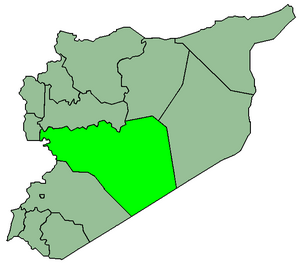Battle of Dapur
| date | 1271 BC Chr. |
|---|---|
| place | Dapur, in today's Homs Governorate in Syria |
| output | Victory of Egypt |
| consequences | Conquest of Dapur by Egypt |
| Parties to the conflict | |
|---|---|
| Commander | |
|
|
|
The Battle of Dapur describes one of the most important conquests of the Egyptian Pharaoh Ramses II during his campaign against the Hittite Empire . In doing so, Ramses succeeded in taking the heavily fortified citadel of Dapur . At that time Dapur was a Hittite city in what is now Homs Governorate in Syria .
prehistory
In the 13th century BC Chr. Fought the Egyptians and Hittites for supremacy in Retjenu (region of present-day Palestine and Syria). After the costly Battle of Kadesh, Ramses II reformed his army and three years later (1271 BC) started another campaign into the Palestinian-Syrian territory, which was still under the rule of the Hittites. Ramses II conquered some important cities such as Gaza , Jaffa , Tire , Sidon and Beirut . The new Hittite great king Muršili III. did not intervene during the campaign of Ramses II. The Pharaoh avoided another attack on Kadesh and marched to the Hittite city of Dapur, which was about 100 km north of Kadesh.
The battle
Not much is known about the troop strength and the exact course of the battle. The pictorial representation in the Ramesseum mortuary temple indicates that Ramses II had an army of chariots , archers and infantry with swords and shields. A rider can also be seen, which may indicate a cavalry . The defenders of Dapur also had archers and spearmen. The Egyptians tried to use ladders to climb the fortress, which the Hittites defended with spears, arrows and stone balls. Eventually Dapur had to surrender and the Egyptians took the city.
consequences
The war of Egypt against the Hittite Empire for the rule in Retjenu did not bring a clear winner in the following period. The rule over the Syrian cities changed again and again. It was only when the Assyrian Empire in the north became a threat to the Hittites that the Hittite Empire closed in 1259 BC. A peace treaty with Egypt , because one wanted to avoid a two-front war. The Egyptian-Hittite peace treaty is the oldest written peace treaty. His statements hang in the UN building in New York .
Archaeological source
The Battle of Dapur had Ramses II depicted on the walls of his mortuary temple Ramesseum in Thebes . You can see the unarmored Pharaoh Ramses II, who runs over the opponents with his chariot and shoots the defenders of Dapur with a bow. Ramses' army storms the fortress with ladders while archers bombard the defenders of Dapur. You can also see Egyptian foot troops protecting two of Ramses' sons with shields. The defenders of Dapur also shoot arrows and projectiles at the attackers and try to repel the climbers with spears. You can also see other chariot units and cavalry.
See also
literature
- Eduard Meyer : History of Antiquity. 2nd volume, 1st abbot; Eduard Meyer: The time of the great Egyptian power, Ramses II and the great Chetite war. Wissenschaftliche Buchgesellschaft, Darmstadt 1981, ISBN 3-534-08915-4 , online version
- Eduard Meyer: History of Antiquity. 2nd volume, 1st abbot; Eduard Meyer: The time of the Egyptian great power, temple buildings and fine arts. The battle paintings. Wissenschaftliche Buchgesellschaft, Darmstadt 1981, ISBN 3-534-08915-4 online version

